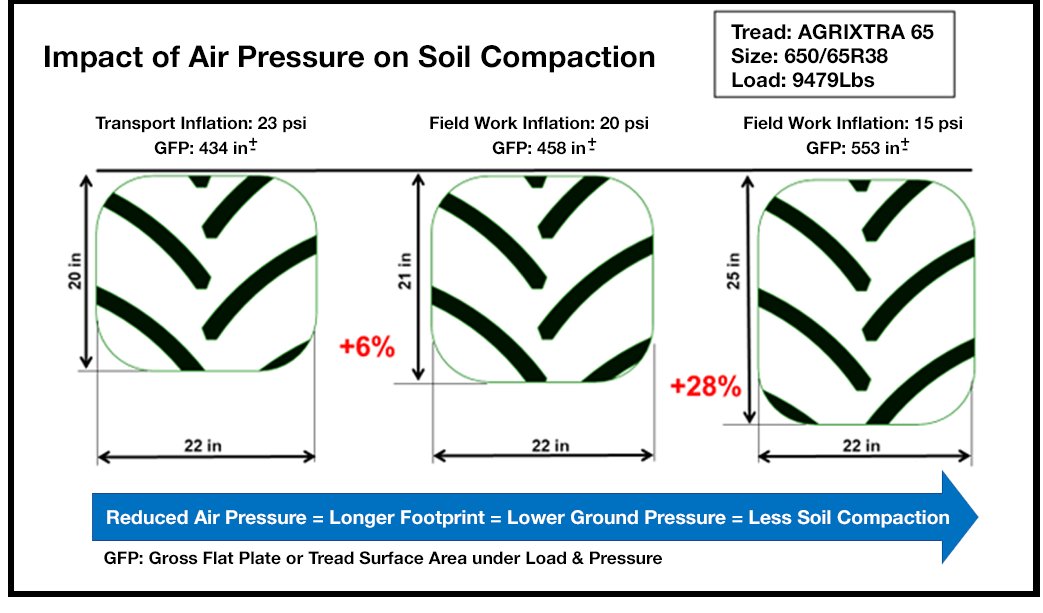OPERATOR Tips to Reduce Soil Compaction
How much soil compaction (% wise) is typically done on the first pass, what are recommended tips relative to defining traffic paths (easy operator changes) and run conditions (dry or wet) to reduce soil compaction, and do you have recommendation on penetrometer usage to determine level and depth of compaction?
AG Tire Talk Takeaways
YOKOHAMA (Alliance): Soil compaction can have a huge impact on crop yields… Tires are actually a key part of the solution. It’s actually easy to figure out—soil compaction force is usually close to a tire’s inflation pressure, so a VF or flotation tire running at 12 psi causes about half as much compaction as a conventional radial running at 25 psi.
BKT: For soil to be healthy, soil particles and pore spaces should be close to 50/50%. When pore spacing is decreased, air and moisture are driven out of the soil. The soil density increases. Research has shown that 70%-80% of compaction is done in the first pass.
MICHELIN: “As a percentage, how much of your soil surface is touched by rubber in a normal annual farming cycle?” …about 90%. There are different theories as to how a producer can avoid this issue. One idea is to simply follow the same tire tracks whenever possible- i.e. following the combine tracks with tractor/grain cart.
PRECISION INFLATION: Bottom line, IF the field is too wet, stay out. IF you go into a marginal field, understand you will be damaging your VALUABLE soil and taking a yield hit for several years.
MAXAM: Tire Tip #2: Use a penetrometer to accurately track soil compaction in your fields. A penetrometer is a tool that will allow a farmer or grower to determine the amount of soil compaction on his field. A penetrometer can help determine how machine loads or axle loads are impacting ground pressure and the resulting soil compaction.
TITAN: Bias tires have been the traditional choice for most planters and implements, but radial tires, while more expensive, offer significant reductions to inflation pressures, resulting in reduced ground-bearing pressure and reduced compaction. For example, 12.5L15 bias tires would typically run at approximately 90 psi, whereas a comparable 230/75R15 radial would run at approximately 56 psi.
CONTINENTAL: The “SOILAssist Sensor System” (SASS) can be placed in the soil to measure the soil deformation from tire pressure and deflection.
BKT USA, Inc.
Dave Paulk: Manager Field Technical Services
Soil compaction can reduce plant growth, root penetration into the soil and root size. Soil becomes compressed (compacted) through agricultural practices, cultivation, and wheeled traffic. It restricts water and air distribution in the soil. This can result in a lack of water and nutrient distribution and can cause slow seed emergence and diminished crop yields.
For soil to be healthy, soil particles and pore spaces should be close to 50/50%. When pore spacing is decreased, air and moisture are driven out of the soil. The soil density increases.
Deep soil compaction is of greater concern than near surface compaction. Soil compaction can be managed and minimized. Prevention of compaction is better than trying to repair it. Once compacted, it can take years to undo the damage.
Research has shown that 70%-80% of compaction is done in the first pass. Compaction can vary depending on the soil type, soil moisture, tire size, air pressures, and total loads. With conventional tillage, research has estimated that 90% of a field can be tracked on during the year. Some of this area can receive as many as 4 or 5 passes a year. By cutting down on the traffic in a field, compaction can be managed, and the subsoil allowed to regenerate.
If possible, farming operations should not be done on wet soil. If the soil is near saturation, the load can be greater than the soil’s ability to support it causing deep ruts and excessive wheel slippage. Heavy fertilizer spreaders, combines, grain carts, and trucks can be destructive on overly wet soil. Improving drainage can reduce having to work in wet fields.
It is much better to work in dry or moist soil. Managing traffic paths and patterns and using only portions of the field for traffic can help manage compaction by not driving on it. Tramlines can be used for sprayers and implements to reduce late season damage to plants which are small field roads created at planting by preventing seeds to fall into those rows.
Using a penetrometer can measure the force needed to insert a cone into the soil. It is inserted by hand at a steady speed to determine the force required to penetrate the soil at a certain depth. The measurement is generally given in megapascals (MPa). Generally, root growth becomes affected when resistance exceeds 1.5 MPa. Root growth is severely restricted at 2.5 MPa or more. Deep soil compaction is excessive compaction below the normal tillage depth. Generally, this starts at about 8 inches depending on the type of soil.
Some other ways to reduce soil compaction include:
- Use only enough ballast to reduce slippage
- Running the correct air pressures for the loads and reducing axle weight. Axle loads of greater than 5 tons increase subsoil compaction.
- Using radial tires instead of bias ply tires. Radials can run at lower air pressures without damaging the tire. Air pressure is directly correlated to soil compaction. The more air needed, the more compaction on the soil.
Michelin Ag
David Graden: Operational Market Manager – Agriculture
During speaking engagements, I like to ask my audiences, “As a percentage, how much of your soil surface is touched by rubber in a normal annual farming cycle?” Most of the time, the answers will range between 15% and 65%. I then point out Spring fertilizing, tillage, planting, spraying, etc., whereas I begin to see a few Aha faces in the audience. Finally, I give the answer of about 90%.
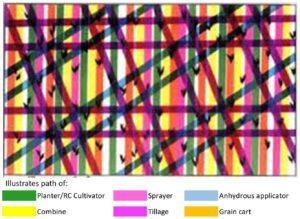
From a soil standpoint, every pass of a machine contributes to more and more compaction. The first pass of a machine will contribute to shallow compaction; however, repeated/overlapping passes contribute to deep compaction, which will eventually lead to “hard pan soil.” Hard pan is a layer of soil that is impermeable to water and needed oxygen, thus hindering the development of yield. In fact, if the soil has a higher moisture content, the soil compaction damage is even greater, due to the liquid state of the soil drying into a solid.

There are different theories as to how a producer can avoid this issue. One idea is to simply follow the same tire tracks whenever possible- i.e. following the combine tracks with tractor/grain cart. Additionally, taking the grain load process off the field has major impact on field ends as tractor trailer high pressure tires with exceedingly high weights coupled with existing multiple tire track soil compaction can easily result in difficult to remedy hard pan.
Another idea is to create or use controlled traffic paths. By following the same tracks on every pass, you could remove all impact from most of the ground and focus all of that compaction into a limited number of tire tracks crossing your field. The downside is, you may have to purchase new equipment with matching widths, so all machines cover the same number of rows.
Another idea is to outfit your machine fleet with Michelin Ultraflex (VF) tires. Independent studies at Harper Adams University in the UK and the University of Illinois – Campaign Urbana have proven a yield gain of up to 4.31% using properly inflated Michelin VF tires vs standard radial tires. Compared to controlled traffic paths, producers wouldn’t have to sacrifice the ground in which they used for their designated tire tracks. This means, improved efficiency, higher yields and a much faster return on investment.
Finally, if you think soil compaction has or is hindering the root development of your crop negatively affecting your yield, you could use a cone penetrometer. A cone penetrometer is a tool used to measure and record the downward force required to penetrate different layers of soil at different depths. This measurement is usually recorded in pounds per square in (PSI). In general, studies have shown a restriction in root development when the penetration resistance exceeds 50-75 psi and severe restrictions or nondevelopment at 75 psi or more. In fact, PennState Extension published the following table to simplify things for users.
https://extension.psu.edu/diagnosing-soil-compaction-using-a-penetrometer-soil-compaction-tester

Bottom line, soil compaction is a very big issue and it is difficult to measure its affects, year over year, in normal farming operations. On the other hand, most of us completely understand that oxygen, water and nutrients are necessary for healthy root development and compacted soil restricts all of these. At Michelin, we continue to focus on the development of technologies that improve yield and efficiency by reducing soil compaction.
Yokohama Off-Highway Tires America
Blaine Cox
Soil compaction can have a huge impact on crop yields, soil health and water infiltration, and it’s something farmers can help minimize through careful tire selection and maintaining the proper inflation pressure. Tires are actually a key part of the solution.
It’s actually easy to figure out—soil compaction force is usually close to a tire’s inflation pressure, so a VF or flotation tire running at 12 psi causes about half as much compaction as a conventional radial running at 25 psi.
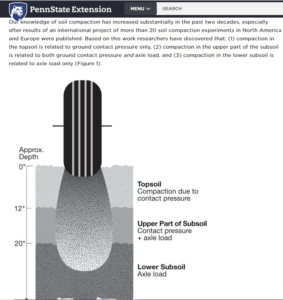
Jodi DeJong-Hughes at the University of Minnesota and her colleagues calculated an average yield loss of 21% in corn and soybeans for two years after compaction damage was caused, and she talks about one field she studied in Minnesota that suffered yield losses for 13 straight years after a single wet harvest.
Compaction isn’t just isolated to the ruts you leave at planting with your tractor. Researchers at the University of North Carolina determined that 50% to 85% of the area of a corn field gets rolled over by at least one piece of equipment during a season. That’s why Yokohama Off-Highway Tires America is so committed to our Whole Farm concept, which is a commitment to offering low-inflation pressure tire not only for heavy tractors, combines and grain carts, but for all the machinery that farmers use, including sprayers, seeders, tillage equipment and other implements.
We talk with farmers about the importance of selecting low-pressure options for as much machinery as possible, whether it’s one of our Alliance Agristar+ VF radials, our fast flotation radials that can be towed at highway speeds, or any of our other IF, VF or flotation tires. We also strongly emphasize the importance of operating at the lowest appropriate inflation pressure for the load and speed of operation.
Central tire inflation systems (CTIS) will really help with that as they become more common, because they make it possible for farmers to adjust between lower pressure for fieldwork and higher pressure for road travel by just pushing a button—and they help your tires last longer, too. But right now, many people just operate at low field pressure and drive more slowly down the road so they can protect their soils from compaction.
We would love to see farmers out using penetrometers to get to know what’s happening beneath the surface as far as the severity and depth of soil compaction, but we know that’s pretty rare. But at the very least, we encourage them to avoid working in fields that are too wet. What’s too wet? I like the old trick of making a ball of soil in your hands like you’re making a snowball, maybe the size of a walnut or an 8-ball. Toss it a few inches in the air and let it land in your palm. If it breaks apart, you should be good to go. If it sticks together, it’s too wet to work—driving on that field will cause soil compaction for sure.

There are some other things you can do to manage compaction. In many parts of the world, farmers drive in the same tracks with all their equipment when they can, pass after pass, year after year. Those “tramlines” are high-compaction sacrifice areas, and they allow the farmers to keep off the rest of the field surface. Another thing you can do is look at your yield maps if you use them and see if you can spot tire tracks or other compaction damage. (I’ll bet you’ll see any shortcuts you took cutting across the field with the grain cart.) Or take a look when you’re cultivating or spraying this summer and see what’s stunted or yellow. You may see first-hand the effects of compaction.
The good news is that your tires can help you minimize that in the future.
Precision Inflation, LLC
Ken Brodbeck, VP of Technology
How to Reduce Soil Compaction: Do’s & Dont’s
DON’T:
- DON’T buy the tractor with the heaviest weight package with the smallest tires or tracks. Bigger tires PROPERLY INFLATED, and wider tracks, both reduce soil compaction and rutting.
- DON’T add large fertilizer tanks to your planting tractor unless you have considered how much more tire pressure is required to carry the extra load.
- DON’T assume tracks have no compaction. There are many farmers who will admit they can see stunted crops where tracks compacted the soil when soil conditions are marginal.
DO’s:
- Depending on the planting or harvesting window, DO stay out of the field if it is too wet. (Standing water in low spots, soil works poorly and/or rutting is obvious and excessive.)
- High Tire pressure = Higher Soil Compaction. DO set tire pressures to minimum to minimize soil compaction and rutting.
- DO have a tire inflation system so you can stay at minimum field pressure and re-inflate for transport, thereby optimizing machine performance for both field and road AND promoting soil health while minimizing soil compaction.
- DO remove extra cast weights from both wheel and track tractors unless absolutely necessary. Excessive Ballast = excessive tire pressure AND excessive pressure under Rubber Tracks.
- DO reduce number of trips across the field. Fewer passes = Fewer compaction areas.
- The passes you do make, DO keep them together to localize any compaction. Example: The grain cart should follow the same path as the combine did.
Bottom line, IF the field is too wet, stay out. IF you go into a marginal field, understand you will be damaging your VALUABLE soil and taking a yield hit for several years.
As my Dad said when we bought our first 325 HP 4WD with dual 24.5-32 tires, “Just because we CAN drag the implement through the wet hole, DOES NOT MEAN WE SHOULD!”
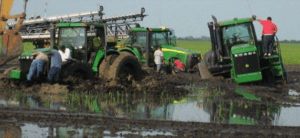
Maxam Tire International
Greg W. Gilland: Business Development & Ag Segment Manager
In agricultural operations, the primary driver for increased crop results or yields is the impact of soil compaction on the plant’s ability to grow. Soil compaction occurs when stress is applied to a surface soil causing artificial densification or thickening as the air is displaced or pushed out from between the soil grains or pores reducing the oxygen content and impeding plant root growth. In agricultural operations when weight or load is applied, it will cause densification due to air and water being pushed or displaced from between the soil grain molecules. Therefore, soil compaction is a normal and inevitable part of agricultural operations.
Soils will vary around the world, but they are essentially made up of the following materials in various amounts: clay, silt, sand, organic materials, and water. Depending on the amount or content of the various components listed above, will determine the soil porosity of the field. Understanding the type of soil and moisture conditions a farmer or grower is facing will help select his equipment utilization, the selected air pressure to carry the load, with the intent to minimize soil compaction and improve his yields.
Soil Compaction is impacted by the following materials:
- Initial soil pore volume (porosity of the soil / mix of soil)
- Perceived or measure water content in the soil (predominant influencer)
- Vehicle speed or compaction speed when operating equipment in the field
- Amount of ground pressure (tire footprint and air pressure caused by axle load)
- The effect of multi-passes on the same area or rows by the equipment
Ground pressure is therefore directly impacted by the tires working the field based on the below contributing factors:
- The total vehicle load per axle and number of tires
- The distribution of the load on each individual, dualled or tripled wheel position
- The type of tire construction radial or bias with their corresponding ground pressure
- The tire inflation pressure per the vehicle or towed weight
- The tire GFP or “gross flat plate” or contact surface area because of tire tread dimension and lug design
- The type and weight of the selected implement in operation
- The amount of power applied and subsequent ground slippage (2WD vs. MFWD, or 4WD)
- Surface soil compaction is mainly impacted by the tire footprint pressures (ex: the larger the footprint, the lower the pressure)
- Deep soil compaction is the resulting function of utilized equipment weight and repeated passes but is largely impacted as well by the type of soil and moisture content
Proposed Solutions to Reduce the Impact of Soil Compaction:
A widely accepted solution is a “traffic or controlled path plans”. Controlled path plans are precise traffic lanes designed to reduce soil compaction by restricting the powered elements of the equipment to travel over exact rows for repeated passes. A traffic path plan will improve vehicle performance, limit the impact to soil conditions, and improve productivity by avoiding row or traffic overlapping. Overlapping the row or traffic lanes results in wasted energy, escalated fuel costs, and increased soil damage due to the subsequent ground pressure generated with every pass. The use of new GPS-driven, traffic or controlled path technology is revolutionizing equipment operation by improving vehicle utilization and reducing the impact of ground pressure (i.e.: soil compaction) on crop yield. Keep in mind that the selected equipment will pass over the same field multiple times to deliver seed, nitrogen, fertilizers, nutrients, and pesticides during the growing cycle. From the Maxam perspective, if the right tire is utilized and in tandem the vehicle actively employs guidance technology or employs a traffic (controlled path) plan, the farmer or grower will avoid row skips or overlaps, ensuring reduced soil damage, and improve the crop yields.
Tire Tip #1: Utilizing the right tire size, at the right air pressure to increase your tire footprint will result in reduced ground pressure or soil compaction = greater yields!
Tire Tip #2: Use a penetrometer to accurately track soil compaction in your fields.
- A penetrometer is a tool that will allow a farmer or grower to determine the amount of soil compaction on his field. A penetrometer can help determine how machine loads or axle loads are impacting ground pressure and the resulting soil compaction.
- The information gleaned can also be used to review and change traffic patterns or row alignment to reduce the impact of soil compaction and increase crop yields.
Active field work during dryer soil conditions is another practical solution that allows for better soil structures and improved yields in the mid or long term. Employing preventative measures such as field drainage helps reduce soil moisture content. Additionally, the use of lime to treat the soil reduces acidity and improves both the fertility and oxygen content levels. Dryer soil conditions ultimately allows for “no-tillage” planting, and the use of residue or remanent organic materials that will result in dryer soils with decreased deep soil compaction. Finally, employing both crop rotation and controlled path field tillage before planting are also good practices for reducing soil compaction over time. Another consideration is that dryer soils have greater weight bearing capacity when compared to wet soils under similar pressure or loads.
Tire Tip #3: The most critical consideration to reduce compaction is to avoid any hard tillage work when soil conditions are extremely wet.
A larger tire footprint (larger diameter, or tread width) will deliver improved performance and reduced ground pressure. You can also impact your tire footprint size by reducing or managing the inflation pressure using scales to weigh each vehicle axle (the lower the pressure: the larger or longer the footprint), resulting in reduced ground pressure. Therefore, a larger tire footprint reduces ground pressure thus reducing soil compaction by increasing the ground coverage area or tread area:

Tire Tip #4: Utilizing tires with a longer or larger contact areas coupled with less field passes will ensure reduced soil compaction.
MAXAM radial agricultural tires have been developed with the load and speed capability to deliver performance in any soil condition worldwide. Our objective is to bring to market radial agricultural products in the right sizes, with the right load capabilities, that when operated at the right air pressure will deliver the value and performance our customers expect. Backed by a world-class warranty program, our radial agricultural tires are manufactured to maximize performance, reduce soil compaction, and improve your yields! Try the MAXAM advantage in your agricultural operations today!
Titan International, Inc. (Manufacturer of Titan and Goodyear Farm Tires)
Scott Sloan: Ag Product Manager / Global LSW
Responses By: Scott Sloan, Ag Product Manager, Titan International
Soil compaction is a common occurrence on the farm, especially by tractors or planters when fields are wet. In fact, estimates show that up to 80 percent of total compaction is caused by the tractor. Even one pass across the field can cause significant soil disturbance, which is why farmers should work to limit field traffic whenever possible. However, with the right tire configuration for tractors and planters, the impact of pinch row compaction can be significantly reduced.
Benefits of Super Singles for Tractors
A common cause of pinch row compaction is using standard OEM duals. The pressure of the narrow duals causes rutting between the tires, disturbing the soil’s ability to maintain a healthy crop development and key nutrients. The pinch row effect from narrow duals has been shown to have a negative impact on yields, through stunted crops, root development and poor seed germination.
However, using Goodyear® Super Single tires, with Titan’s exclusive Low Sidewall Technology® (LSW®), farmers can significantly increase the footprint while reducing ground-bearing pressure. They feature a larger rim diameter and a smaller sidewall than a standard tire, while maintaining the same outside diameter of a comparable standard tire. LSW tires meet all the same load and inflation capabilities as VF and CFO tires, meaning they can also help reduce soil compaction. Our Goodyear LSW1100/45R46 single rears and LSW1000/40R32 single fronts can help reduce compaction by spreading pressure out over a larger footprint. See the figure below.
Titan also conducted a field study with agronomists on two identical test plots planting corn in Sikeston, MO — one planted with a tractor running a narrow dual configuration, the other planted with Goodyear Super Single tires. Results showed that the test plot with the Super Single tires yielded five more bushels per acre compared to the duals. The example below demonstrates that an additional five bushels per acre at $5.54 per bushel on 1,500 acres could add an extra $41,550 in annual profit by running Goodyear Super Single tires.
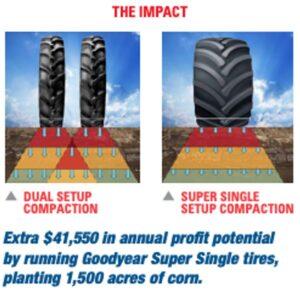
Radial or Bias Tires for Planters
Central-fill planter traffic can also often increase pinch row compaction. In wet soil conditions at planting – enough to create compaction – averages of yield loss have been nearly 20 bushels per acre between pinch rows and wing rows on a center-fill planter in 30″ rows.
Bias tires have been the traditional choice for most planters and implements, but radial tires, while more expensive, offer significant reductions to inflation pressures, resulting in reduced ground-bearing pressure and reduced compaction. For example, 12.5L15 bias tires would typically run at approximately 90 psi, whereas a comparable 230/75R15 radial would run at approximately 56 psi.
With the right tire configuration for both tractors and planters, farmers can better minimize soil disturbance and preserve organic residue to increase their yield.
Continental Agriculture North America
Harm-Hendrik Lange: Customer Solutions Engineer for Continental Commercial Specialty Tires (CST)
Many institutions and universities have been testing and assessing soil compaction for years. It is well known that soil types with high clay particle content are more prone to staying compacted and are not easily churned up with implements, like with more sandy soil types. Higher humidity, up to wet conditions, works a little like glue when creating a paper mache mold. Climates with high humidity provide the paste to the clay ‘paper strips’, that once dry, creates a hardened and compacted structure. The surface tension between the dried clay particles prevents the soil from being released easily with implements.
When you work in wet, or partially wet, clay soil fields (or even on loam that is a mixture of different particles, but predominantly clay), be aware of the potential harm that can be caused to the soil.
The first passage with your equipment; in muddy, swampy, or post storm conditions, can compact the clay/loam type soil almost to the maximum level. It is advised not to do field work with this level of moisture, if it can be prevented. At mid to slightly higher humidity, the drastic soil compaction can happen, but here it’s more likely on the second passage or if you ride the first passage very slowly but with vibration excitation (maybe due to PTO implements that are not balanced) that can make the tractor act like a vibration plate. Tires also play a key role on soil compaction. The best advice is to run tires at the minimum required inflation pressure in order to increase the footprint and decrease the ground contact pressure.
A German institute, Thünen-Institut, conducted tests with sensors at 20cm, 35cm and 50cm soil depth to show that the first pass only created significant compaction of air pores in 20cm depth once the self-driving slurry tanker was operated in dog-walking-mode (rear tires running on parallel tracks of the front tires). If the dog-walking-mode is enabled, it means the rear tires pass the same tracks of the front tires, and the compaction at 20cm deep was much more significant, but also quite significant at 35cm deep. When using a standard tractor with a 2-axle trailering slurry tanker, instead of the self-driving slurry tanker, this increases the tire passages to 4 per track and proved that compaction could be measured even at 50cm.
The “SOILAssist Sensor System” (SASS) can be placed in the soil to measure the soil deformation from tire pressure and deflection. Normal soil penetrometers (in most of the cases, the penetrometer scale is green from 0-200 psi, yellow from 200-300 psi, and red from over 300 psi) can give a first feeling while measuring the compaction of “untouched” and “under-track” soil, in comparison of the same soil and same day. But with the penetrometer it’s difficult to really repeat comparable numbers on different days, or to compare values measured on different fields and with different humidity. Furthermore, if small stones are in the soil, this can disturb the values and precision of a penetrometer a lot. Compared to SASS, the penetrometer is rather a rough indicator to give the user a feeling of how he/she is harming the soil, but unfortunately less repeatable.
https://www.soilassist.de/fileadmin/soilassist/2016_SOILAssist_Poster_sensor_system.pdf
All information is provided in this blog solely to provoke thought. All deductions made from information on this site must be confirmed by Certified Ag Tire Dealer and tire manufacturer where specified before use. Ag Tire Talk does not recommend anyone conduct tire service work with exception of Certified Ag Tire Dealer Professionals.

